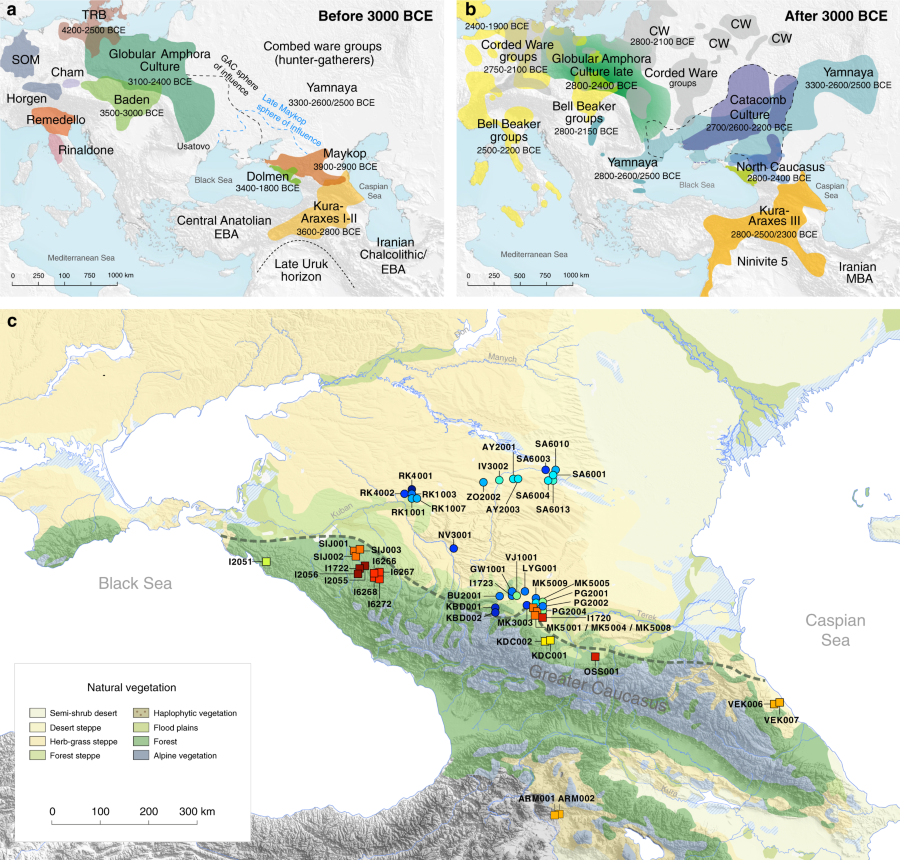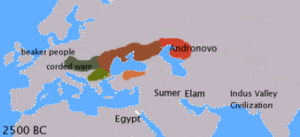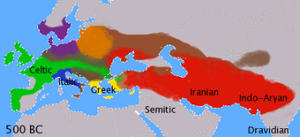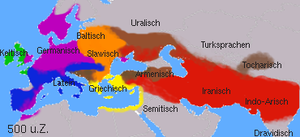
Dlaczego i Reich i indo-germańska wikipedia kręcą i kłamią?
Ten wpis nawiązuje do:
O przeciw-logicznej, przeciw-słowiańskiej i nazistowskiej propagandzie Reicha i jego kolegów z Max Planck Institute pisałem już tu:
Bierzcie i czytajcie to wszyscy, albowiem oto jest ofitzjalna indo-germańska / fielko-germańska fietza, wsparta autorytetem Harwardu, Max Planck Institute w osobie prof. Davida Reicha.





Die Karten zeigen die vermutete geographische Ausbreitung und die Differenzierung der indogermanischen Sprachen bis ca. 500 n. Chr.
Mapy pokazują założony zasięg geograficzny i zróżnicowanie języków indogermańskich do około 500 roku naszej ery.
…..
(…) Diese These steht in starkem Zusammenhang mit der Anatolien-Hypothese, baut aber auf linguistische sowie genetische Daten aus den Jahren 2018 und 2019 auf. Analysen zur Ausbreitung der Indogermanischen Sprachen weisen auf eine Urheimat im südlichen Kaukasus und dem nördlichen Iran hin.[16][17]
Eine genetische Studie (Wang; Reich et al 2018) unterstützen diese These. Den Wissenschaftlern zufolge stimmt die DNA der frühen Indogermanen mit den Bewohnern des südlichen Kaukasus und des nördlichen Irans überein. Ihnen zufolge wanderten diese Ur-Indogermanen einerseits nach Anatolien und andererseits Richtung Norden in die südlichen Steppenregionen in denen später die Yamna-Kultur entstand.[18] (…)
(…) Hipoteza ta jest silnie związana z hipotezą Anatolijską, ale opiera się na danych językowych i genetycznych z lat 2018 i 2019. Analizy rozprzestrzeniania się języków Indogermańskich / Indogermanische wskazują na ojczyznę na południowym Kaukazie i w północnym Iranie [16] [17]
Badanie genetyczne (Wang, Reich i in. 2018) potwierdza tę tezę. Według naukowców DNA wczesnych Indoeuropejczyków zbiega się z mieszkańcami południowego Kaukazu i północnego Iranu. Według nich, te starożytni Indogermanie / Indogermanen migrowali z jednej strony do Anatolii, a z drugiej strony na północ w południowe regiony stepowe, w których później powstała kultura Jamna. (…)
Doprawdy?!! Powtórzę: Doprawdy?!!
😍 😂 😳 😞 😖 LOL 😄 😆 😃 😍 😈
I to dlatego np. potomkowie tych Indo-Germanów, jak np. Baskowie z R1b i w 100% potomkowie Bell Beakers pochodzących ze stepu z kultury Jamowej / Yamna / Yamnaya,.. mówią w języku baskijskim, Nie-Indo-Germańskim, który to język jest porównywany do j. kartwelskich, jak j. gruziński..?!!
Ciekawe jest też np. to, że inne badania zaprzeczają wymianie genów z południa Skałkazu, a sam Skałkaz jest nazwany „barierą genetyczną”, patrz:
https://onlinelibrary.wiley.com/doi/abs/10.1046/j.1529-8817.2004.00092.x
Mitochondrial DNA and Y‐Chromosome Variation in the Caucasus
I. Nasidze
First published: 02 June 2004
https://doi.org/10.1046/j.1529-8817.2004.00092.x
Summary
We have analyzed mtDNA HVI sequences and Y chromosome haplogroups based on 11 binary markers in 371 individuals, from 11 populations in the Caucasus and the neighbouring countries of Turkey and Iran. Y chromosome haplogroup diversity in the Caucasus was almost as high as in Central Asia and the Near East, and significantly higher than in Europe. More than 27% of the variance in Y‐haplogroups can be attributed to differences between populations, whereas mtDNA showed much lower heterogeneity between populations (less then 5%), suggesting a strong influence of patrilocal social structure. Several groups from the highland region of the Caucasus exhibited low diversity and high differentiation for either or both genetic systems, reflecting enhanced genetic drift in these small, isolated populations. Overall, the Caucasus groups showed greater similarity with West Asian than with European groups for both genetic systems, although this similarity was much more pronounced for the Y chromosome than for mtDNA, suggesting that male‐mediated migrations from West Asia have influenced the genetic structure of Caucasus populations.
…..
https://www.ncbi.nlm.nih.gov/pubmed/21917723
The Caucasus as an asymmetric semipermeable barrier to ancient human migrations.
Yunusbayev
doi: 10.1093/molbev/msr221. Epub 2011 Sep 13.
Abstract
The Caucasus, inhabited by modern humans since the Early Upper Paleolithic and known for its linguistic diversity, is considered to be important for understanding human dispersals and genetic diversity in Eurasia. We report a synthesis of autosomal, Y chromosome, and mitochondrial DNA (mtDNA) variation in populations from all major subregions and linguistic phyla of the area. Autosomal genome variation in the Caucasus reveals significant genetic uniformity among its ethnically and linguistically diverse populations and is consistent with predominantly Near/Middle Eastern origin of the Caucasians, with minor external impacts. In contrast to autosomal and mtDNA variation, signals of regional Y chromosome founder effects distinguish the eastern from western North Caucasians. Genetic discontinuity between the North Caucasus and the East European Plain contrasts with continuity through Anatolia and the Balkans, suggesting major routes of ancient gene flows and admixture.
…..
https://www.cell.com/current-biology/comments/S0960-9822(17)30695-4
Eight Millennia of Matrilineal Genetic Continuity in the South Caucasus
Ashot Margaryan
Published:June 29, 2017DOI:https://doi.org/10.1016/j.cub.2017.05.087
Summary
The South Caucasus, situated between the Black and Caspian Seas, geographically links Europe with the Near East and has served as a crossroad for human migrations for many millennia [1, 2, 3, 4, 5, 6, 7]. Despite a vast archaeological record showing distinct cultural turnovers, the demographic events that shaped the human populations of this region is not known [8, 9]. To shed light on the maternal genetic history of the region, we analyzed the complete mitochondrial genomes of 52 ancient skeletons from present-day Armenia and Artsakh spanning 7,800 years and combined this dataset with 206 mitochondrial genomes of modern Armenians. We also included previously published data of seven neighboring populations (n = 482). Coalescence-based analyses suggest that the population size in this region rapidly increased after the Last Glacial Maximum ca. 18 kya. We find that the lowest genetic distance in this dataset is between modern Armenians and the ancient individuals, as also reflected in both network analyses and discriminant analysis of principal components. We used approximate Bayesian computation to test five different demographic scenarios explaining the formation of the modern Armenian gene pool. Despite well documented cultural shifts in the South Caucasus across this time period, our results strongly favor a genetic continuity model in the maternal gene pool. This has implications for interpreting prehistoric migration dynamics and cultural shifts in this part of the world.
…..
https://www.biorxiv.org/content/10.1101/322347v1
The genetic prehistory of the Greater Caucasus
Chuan-Chao Wang
Posted May 16, 2018.
doi: https://doi.org/10.1101/322347
Abstract
Archaeogenetic studies have described the formation of Eurasian ‘steppe ancestry’ as a mixture of Eastern and Caucasus hunter-gatherers. However, it remains unclear when and where this ancestry arose and whether it was related to a horizon of cultural innovations in the 4th millennium BCE that subsequently facilitated the advance of pastoral societies likely linked to the dispersal of Indo-European languages. To address this, we generated genome-wide SNP data from 45 prehistoric individuals along a 3000-year temporal transect in the North Caucasus. We observe a genetic separation between the groups of the Caucasus and those of the adjacent steppe. The Caucasus groups are genetically similar to contemporaneous populations south of it, suggesting that – unlike today – the Caucasus acted as a bridge rather than an insurmountable barrier to human movement. The steppe groups from Yamnaya and subsequent pastoralist cultures show evidence for previously undetected farmer-related ancestry from different contact zones, while Steppe Maykop individuals harbour additional Upper Palaeolithic Siberian and Native American related ancestry.
Kliknij, aby uzyskać dostęp 322347.full.pdf
I poniżej poprawiona wersja z tego roku. To z niej pochodzi zamieszczony na górze obrazek…
https://www.nature.com/articles/s41467-018-08220-8
Ancient human genome-wide data from a 3000-year interval in the Caucasus corresponds with eco-geographic regions
Chuan-Chao Wang, Sabine Reinhold, […]Wolfgang Haak
Nature Communicationsvolume 10, Article number: 590 (2019)
…..
Reich (i Haak też!) w swoich indo-germańskich, a właściwie fielko-germańskich twierdzeniach, powołuje się na dane z pracy Wang et al,.. tyle tylko, że one dowodzą czegoś ZUPEŁNIE INNEGO!!! (Tym gorzej dla danych, a co tam!)
Wg tej najnowszej, ale w sumie jedynie odświeżonej tzw. teorii armeńskiej, czy też jakoś irańsko-anatolijskiej inaczej, tzw. semicka haplogrupa J2 ma być tzw. indoeuropejska, a właściwie indo-germańska. Haplogrupa R1a właściwie nie ma z tym wiele wspólnego, itp!!!
Wygląda na to, że wg Reicha i niemieckojęzycznej wikipedii, itp, Pra-Indo-Germanie posiadali haplogrupę J2 i w dalszej kolejności haplogrupy R1b i R1a.
Wygląda na to, że Ariowie to już nie R1a Z93, ale J2. Wcześniej przyszli coś jakby z Ganj Dareh, a wcześniej… hm… To w sumie ofitzjalnie twierdzą indo-germańscy / fielko-germańscy naukowcy ze współczesnych Niemiec i USA!
WHG i EHG zupełnie dla nich nie istnieje! W sumie istnieje dla nich tylko CHG!
Czy J2 ma jakieś związki z ANE i Chłopcem z Mal’ta, skoro (wg Gaska) CHG już miał, jako swoją domieszkę 24,000 lat temu?
…..
Dlaczego i Reich i indo-germańska wikipedia kręcą i kłamią?
Kasa, misie, kasa i wszystko inne tyż!
To nie jest zabawa. To jest nic innego, jak ciąg dalszy pustynnego obrzezywania i wyniszczania pamięci o Tradycji Północno-Euro-Azjatyckich Łowców Zbieraczy, czyli Tradycji Naszych Słowiańskich Przodków!
Reich, jego koledzy z Max Planck Institute, Kristiansen i inni, z tymi ich tradycyjnymi goebbelsowskimi kłamstwami wpisują się w długą niechlubną listę indo-germańskich / fielko-germańskich kłamców i krętaczy.
Pra-Słowiańszczyzna, a następnie Słowiańszczyzna i to, co z niej po 2000 lat niszczenia zostało, to dla nich nadal śmiertelny wróg. Zacytuję tu nauczyciela nauczycieli Reicha i jego fielko-germańskiej kompanii…
Zwykła propaganda ma niewiele wspólnego z obiektywizmem i jeszcze mniej z prawdą.
Im większe kłamstwo, tym ludzie łatwiej w nie uwierzą.
Kłamstwo powtórzone tysiąc razy staje się prawdą.
https://pl.wikiquote.org/wiki/Joseph_Goebbels
Wcale Mię to wszystko już nie śmieszy, zwłaszcza po tym, jak „rzetelnie” do podobnych zagadnień podeszli i Rudaweb i Histslov, czyli „słowiańscy znawcy tematu”. No cóż, trzeba brać się do roboty i zadeptać to neonazistowskie allo-allo kłamstwa w zarodku, albo czas zacząć się bać! 😦 Czytaj dalej
